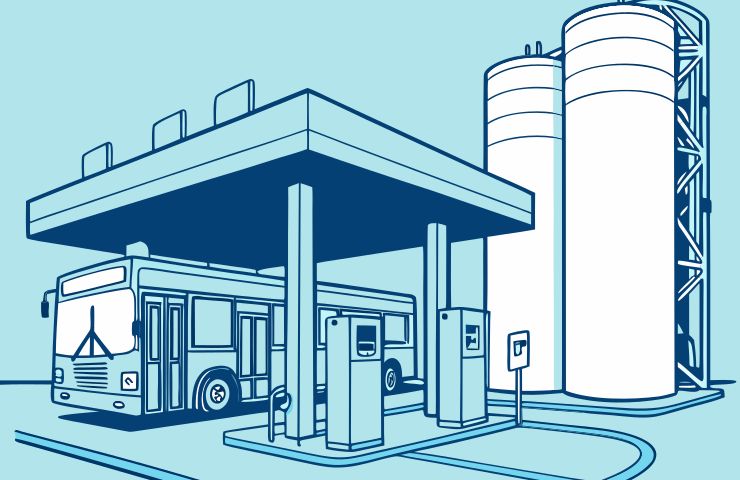
Hydrogen Fueling Station to Power GCTD’s Zero-Emission Transit Fleet
November 20, 2025In Ventura County, California, the next leap in clean public transit is taking shape at Oxnard’s bus depot. Clean Energy Fuels Corp. has announced it’ll take the lead in designing, building, and maintaining the Gold Coast Transit District’s very first hydrogen fueling station. Backed by a $12.1 million grant from the Federal Transit Administration, it’s scheduled to roll out in 2027. Once up and running, it’ll fuel five hydrogen fuel cell electric buses out of GCTD’s roughly 70-strong fleet—a huge stride toward the district’s 2040 zero-emission goal.
What makes hydrogen so tempting? For starters, it’s all about zero-emission technology and agility. Unlike battery-electric buses that need long charging stops and pricey grid upgrades, fuel cell buses top off in about ten minutes—just like today’s CNG setups. They pack a punch with nearly three times the gravimetric energy density of lithium-ion batteries, so one tank can carry them 250–300 miles down the road. That kind of range is a game-changer for GCTD, which moves more than 843,000 residents around Oxnard, Ventura, and neighboring cities. Better yet, when that hydrogen comes from renewable electrolysis or biogas, lifecycle greenhouse gases dive by over 60% compared to CNG, pushing the envelope in sustainable energy.
Safety and Infrastructure Design
The future fueling hub, nestled in GCTD’s Oxnard maintenance yard, is built for high-pressure hydrogen storage at 700 bar. Day one throughput sits around 600 kg, but there’s plenty of room to grow. Its modular setup—skid-mounted compressors, storage vessels, dispensers—means quick installation. Until onsite electrolysis is in play, Clean Energy Fuels Corp. may truck in hydrogen from regional producers. A SCADA system will keep an eagle eye on pressure, flow, and leaks, feeding live data to a central control room. Safety isn’t an afterthought: hydrogen-specific flame arrestors, automatic shutdown valves, ventilation fans, and multi-tier gas sensors tie into isolation protocols. And drivers? They’ll refuel with standard nozzles, so the learning curve is minimal.
Fuel Cell Bus Technology 101
Every 40-foot fuel cell electric bus from New Flyer uses a proton exchange membrane fuel cell (PEMFC) stack cruising at around 114 kW. Hydrogen at 700 bar feeds the stack, reacts with air, and churns out electricity on the spot. A 60 kW battery buffer handles peak loads and captures energy during braking. The result? Snappy acceleration, more than 250 miles on a fill, and hydrogen use hovering around 8–10 kg per 100 miles. Oh, and the only tailpipe “emissions”? Pure water vapor.
Policy and Strategic Implications
This project leans on the FTA’s Low or No Emission Vehicle Grant Program—a key piece of federal momentum to decarbonize transit. For Clean Energy Fuels Corp., already GCTD’s RNG supplier, it bolsters their hydrogen infrastructure portfolio. California’s Innovative Clean Transit Regulation also kicks in: 25% of buses must be zero-emission by 2026, 50% by 2030, and a full fleet swap by 2040. Tapping both federal dollars and state mandates shields GCTD from future carbon penalties and unlocks extra incentives.
Project oversight is in capable hands, too. The Center for Transportation and the Environment will orchestrate vendors, contractors, and local stakeholders, while Ventura County Community College partners will train technicians on FCEB maintenance and station ops.
Contextual Backdrop
GCTD kicked off its green journey in 2018—ditching diesel for CNG, then adding electric sedans and vans. By teaming up with Clean Energy Fuels Corp. on RNG, they’re already reusing parts of their fueling network and staff know-how, making the pivot to hydrogen smoother than you’d think.
Scaling Up and Broader Impacts
Phase one might only cover five buses, but this station is built to support up to 50 fuel cell vehicles. As green hydrogen production climbs—thanks to renewables-powered electrolysis—GCTD could retire its CNG fleet well ahead of 2040. The upsides go beyond cutting emissions: think cleaner air, healthier communities, and a wave of advanced-energy jobs in station ops and bus upkeep. Plus, the site could open its pumps to private and municipal fleets, sparking a regional hydrogen hub.
On the Road Ahead
After 2027, GCTD’s Oxnard station could become the go-to blueprint for mid-sized transit agencies across the country. By juggling day-to-day service demands with bold climate ambitions, Ventura County is showing how hydrogen infrastructure and hydrogen fuel cells can deliver real-world wins—operationally and environmentally.


 With over 15 years of reporting hydrogen news, we are your premier source for the latest updates and insights in hydrogen and renewable energy.
With over 15 years of reporting hydrogen news, we are your premier source for the latest updates and insights in hydrogen and renewable energy.